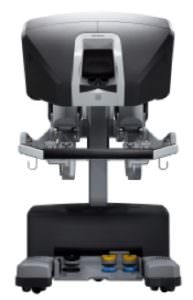Robotic Surgery
Once considered science fiction, robotic surgery has now become mainstream. Currently, the da Vinci® Surgical System (Intuitive Surgical) is the platform most commonly used. This system was introduced in 1999. Dr Laker was certified by Intuitive Surgical to perform robotic surgery in 2005.
Small incisions (8-15 mm) are made through which plastic/metal tubes, referred to as “ports”,arepassed into the body cavity to provide access for the instruments. CO2 is delivered into the body cavity creating working space. The robot arms are docked (connected) to the ports and the camera and robotic instruments are passed through the ports and into the body.
The operating surgeon is seated at a console. The console is typically located in the same room as the patient, but theoretically, could be as remote as Alaska. The console provides a 3D real time image of the body and the surgeon’s fingers slide into a series of Velcro finger rings. Finger movements will open and close the jaws of the instrument (think of pinching a grape and letting it drop). Turning a needle is performed by turning the wrist. The movements are intuitive (so comes the company’s name). Uses for the da Vinci® Surgical System now includes most surgical specialties. Robotic use in hernia repair is an area garnering a lot of attention.
Inguinal Hernia
At this time there is only evidence to support that the da Vinci® Surgical System provides a method of reproducing a laparoscopic inguinal hernia repair (TAPP). This operation has been performed laparoscopically for more than 15 years with excellent results. The robotic platform provides surgeons who cannot perform highly skilled laparoscopic tasks the ability to do so. The dissection, placement of mesh and closure of the peritoneal flap are performed exactly in the same manner as the laparoscopic approach. There has been no difference in outcomes including infection, recurrence, pain, need for analgesics and return to work. The extra costs involved with robotics are not justified if the surgeon can provide a safe, durable and reproducible procedure in a laparoscopic fashion.
Use of the robot for inguinal hernia repair may not make sense for every patient. Indications for the use of the robot generally include obesity, massive inguinal hernias and recurrent hernias. DrLaker will discuss with you what surgical approach makes the most sense.
Ventral hernias (umbilical, epigastric, incisional)
The pores size and location of mesh placement are pivotal in how the material is incorporated into the surrounding tissue. Incorporation describes how the body reacts to the mesh. When mesh is well incorporated tissue grows through the pores of the mesh and the mesh is integrated into the tissue. Incorporation, in turn, reduces the potential for recurrence, infection, erosion and the sensation of foreign body. Light or medium weight mesh (large pores) that is placed between the layers of the abdominal wall typically has excellent incorporation.
The robotic system enables the surgeon to operate on the undersurface of the abdominal wall. The natural tissue planes can be developed between the layers of the abdominal wall. The mesh can be positioned behind the rectus muscles (six packs) and the connective tissue can be closed behind the mesh re-establishing the normal abdominal wall anatomy. This is extremely difficult to perform and reproduce laparoscopically.
Dr Laker is currently performing the majority of his ventral hernias in a laparoscopic or robotic fashion. The robot is able to provide complex reconstruction through a minimally invasive approach.



